After hearing the term ‘Food Forest’, I couldn’t wait for the fall plant sale at NW Bloom – I was on my way right after my first morning meeting, heading out into areas near me with a lot more land! I was envious – even though I’m grateful for my generous 1/3 acre in the burbs, having more land to play with seems like such a fun luxury.
I’m warmly greeted at NW Bloom and feel right at home with chickens wandering through the grounds. There are plants everywhere! I reintroduce myself to Jessi Bloom, whose work on sustainability gardening in the Northwest I just adore. I already had devoured her Free-Range Chicken Gardens book and I had heard her lecture late last spring about Permaculture practices and creating a ‘Food Forest Garden’. YES! I’m in! So much of the array of plant material that she talks about is not the normal types of species that you hear about in garden talks. She’s ventured into some fun areas that are fairly new to me and sounded exactly like what I want to do with my little plot of land. I was so encouraged by the wide variety of plant material that would do well with part-sun and shady areas.
It may sound odd coming from an artist, but I really like the idea of choosing plants that provide more that just aesthetic value. The idea that you can feed yourself off of your land has always appealed to me – but how do you do that with a small urban plot? And what if you want more that just your annual crop of veggies; e.g., what’s beyond lettuce and tomatoes? We’ve all heard of ‘companion planting’, but what about terms like ‘Biodiversity’, ‘Polyculture’, and ‘Plant Guilds’? I was on fire with the possibilities!
Companion Planting is the concept most people are familiar with; this is the idea of the Three Sisters – growing corn, beans and squash together; e.g., the corn grows tall and the stalks provide the beans a place to grow up leaving the squash most of the ground to sprawl around. Plant guilds take the same principle but apply that to perennial plants – love perennials – they are the plants that keep on giving.
Then there are certain ecological functions of plants to pay attention to:
- Soil Building: These plants are nitrogen fixers, mulch/biomass producers, dynamic (nutrient) accumulators and/or help loosen the soil with more spike-like roots.
- Fauna Support: These have nutritional or medicinal value, provide shelter habitat, are insectaries – which means they attract beneficial insects and/or they are pest repellants by secreting compounds that keep pests away.
I came home with all my car could carry:
Columnar Apples (2). This is my solution to forfeiting my precious sun for fruit trees. The columnar fruit trees grow vertically and if I plant them on the North side of my garden – they won’t take away any sun from the rest of the garden. I got 2 for pollination, a Scarlet Sentinel and a North Pole.
Italian Plum, I love Italian plums and this one is a more vertical shape rather that branching out so fingers crossed.
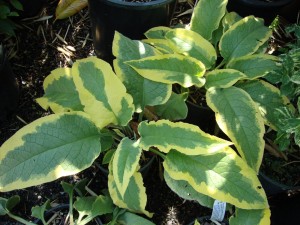
Variegated Comfrey (2) Comfrey is a perennial herb and seems to be a favorite with permaculture design. I’ve grown it for years but am glad to be bringing in the variegated variety. I began growing it originally for it’s medicinal uses, primarily for poultices that can speed up the healing of broken bones, sprains and wounds. Comfrey roots also go deep and bring up nutrients from way down in the earth, which makes it a great dynamic accumulator. Chickens love to eat the leaves so they get all of those great nutrients as well. Comfrey is also a biomass producer so you can cut it back several times a year and it will keep on growing. I will plant under my new fruit trees, which will provide on-going nutrients so I won’t have to fertilize! I’ll used a method called “Chop & Drop”, which basically means that when I cut back the plant, I’ll just chop it in small pieces and drop it right where it is to mulch the area.
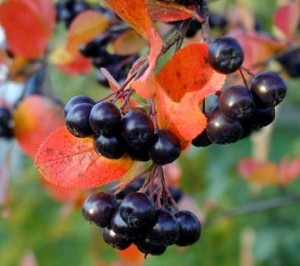
Chokeberry, Aronia Melanocarpa (2), one for the chickens and one for the humans! Chokeberries are high in antioxidants, chickens love them and I can’t wait to incorporate them into my diet.
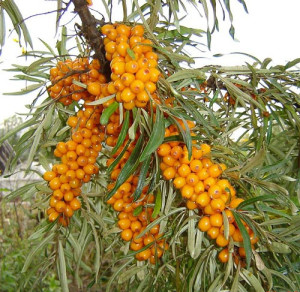
Sea Berry (2 male and female plants). Both a male and female plant are necessary for pollination and should be located within 20 feet of each other since the flowers are wind pollinated.
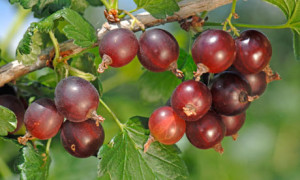
Black Current, Jostaberry. This version doesn’t have the thorns that currents have and is disease resistant. Jostaberries are good eaten fresh or in jams and pies. It’s supposed to taste like a mix of grape, blueberry and kiwi.
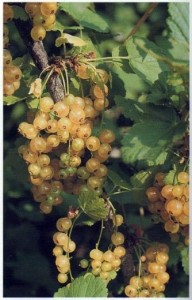
White Current, White Pearl. This variety produces abundant clusters of these translucent berries on a pretty compact little shrub. They make good jellies and can be just eaten fresh.
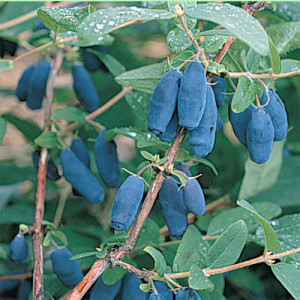
Honeyberry, Blue Moon – This variety produces fruit that ripens early which is always nice and encouraging to us gardeners. Honeyberries are high in antioxidants, vitamins and minerals and they are supposed to taste similar to blueberries but some say it’s a combination of different tastes. I guess I’ll just have to wait to form my own opinion – but those elongated blue berries are very intriguing!
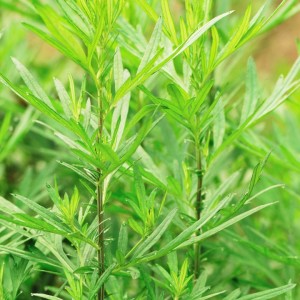
Mugwort, from the Artemisia family. Mugwort has been around for ages and has numerous uses throughout the world in teas, flavorings in soups, salads and external uses. Chinese use it for Moxibustion in acupuncture therapy. I’ve used dried leaves along with other herbs to make ‘Dream Pillows’ because it can induce dreaming. The dried leaves can be used like a bouquet garni in making an herbal rinse to wash off toxins after saunas and hot tubs.
I’ll be getting these new kids in the soil this weekend so they’ll have all fall and winter to get settled before spring. This spring, I’m looking forward to having Jessi come out and walk through my garden with me. I can’t wait to get some new, very seasoned perspectives on the possibilities that lie waiting for the Food Forest in my little urban farm. Thanks Jessi!






